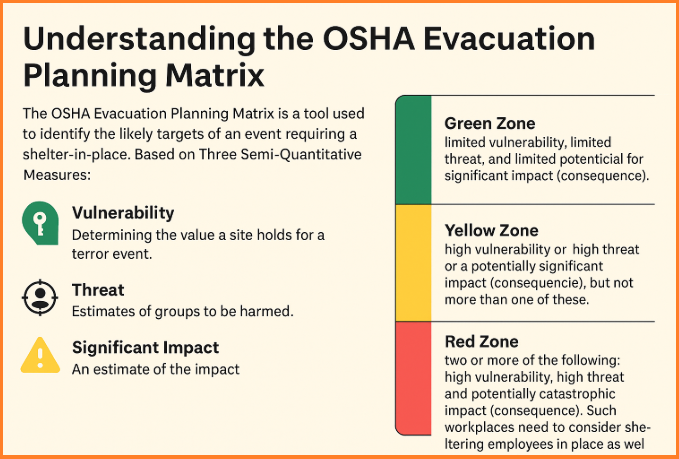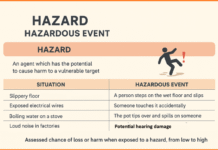The OSHA Evacuation Planning Matrix is a strategic risk assessment tool designed to help organizations prepare for emergencies, particularly those involving terrorist threats or other security incidents. Its primary function is to identify potential shelter-in-place scenarios by analyzing key risk factors related to a workplace’s vulnerability to such events.
This matrix guides decision-making by placing workplaces into risk zones based on three semi-quantitative criteria:
Contents
1. Vulnerability
This refers to how attractive a target the site is for a terrorist attack or a similar disruptive event. Factors influencing vulnerability include:
- High population density
- Symbolic value of the site (e.g., government offices, critical infrastructure)
- Public visibility or media presence
- Ease of access to the location
2. Threat
This measures the likelihood that a particular group may target the facility. It involves assessing:
- Intelligence or history of threats
- Proximity to known high-threat areas
- Ongoing geopolitical or social tensions
3. Impact (Consequence)
This estimates the potential consequences of an incident occurring at the site. It includes:
- Number of people affected
- Environmental or structural damage
- Economic or operational disruptions
- Public panic or health emergencies
Risk Zoning System
Based on the combination of the above measures, workplaces are placed into one of three zones:
Green Zone
- Low vulnerability, low threat, and low potential for impact.
- These sites are considered safe under most conditions.
- Standard evacuation plans and routine drills are typically sufficient.
Yellow Zone
- Any one high factor (either vulnerability, threat, or impact).
- Requires a more detailed emergency preparedness plan.
- May include enhanced communication systems, partial lockdown procedures, or designated safety coordinators.
Red Zone
- Two or more high factors (vulnerability, threat, or impact).
- Indicates a high-risk facility.
- These workplaces should:
- Develop comprehensive shelter-in-place procedures
- Implement evacuation drills specific to terrorist or mass casualty events
- Consider assigning roles to certain employees in responding to such emergencies
- Coordinate closely with local law enforcement and emergency responders
Why Use the OSHA Matrix?
- Provides a structured, risk-based approach to emergency planning.
- Helps organizations allocate resources efficiently for evacuation and sheltering.
- Enhances employee safety by preparing for the worst-case scenarios.
- Encourages proactive communication and coordination with external emergency services.
The OSHA Evacuation Planning Matrix is more than just a compliance tool—it’s a life-saving framework. By identifying vulnerabilities, assessing threats, and estimating potential impacts, it allows employers to prepare and protect their workers effectively. For workplaces that fall into the Red Zone, the responsibility is even greater—to not only evacuate, but to potentially shelter and defend.
Proper planning using this matrix ensures that when disaster strikes, response is not just possible—it’s practiced and prepared.
OSHA Evacuation Planning Matrix – FAQ
1. What is the OSHA Evacuation Planning Matrix?
The OSHA Evacuation Planning Matrix is a tool developed to help organizations assess their risk and prepare for emergencies, especially incidents that might require sheltering in place (like terrorist attacks). It evaluates a workplace based on vulnerability, threat, and potential impact, and categorizes it into risk zones.
2. What are the three semi-quantitative measures used in the matrix?
The matrix uses:
- Vulnerability – How likely the site is to be targeted.
- Threat – The probability of a threat group targeting the site.
- Significant Impact (Consequence) – The severity of the outcomes if an incident occurs.
3. What do the Green, Yellow, and Red Zones represent?
- Green Zone: Low risk – minimal need for special sheltering plans.
- Yellow Zone: Medium risk – needs enhanced planning and monitoring.
- Red Zone: High risk – requires both evacuation and shelter-in-place planning, possibly assigning employees emergency response roles.
4. What kind of workplaces are typically in the Red Zone?
Examples include:
- Government buildings
- Chemical plants
- Critical infrastructure sites
- High-profile or symbolic locations
These sites may face multiple high-risk factors and require detailed emergency response strategies.
5. What does “shelter-in-place” mean?
Shelter-in-place means staying indoors and securing the location during an emergency rather than evacuating. This may involve:
- Sealing doors and windows
- Moving to a protected interior room
- Waiting for an “all clear” signal from authorities
6. Should every organization use this matrix?
Yes. Regardless of size or industry, all organizations benefit from using this tool to evaluate risk and ensure employee safety in various emergency scenarios.
7. How often should the matrix assessment be updated?
Ideally, it should be reviewed annually or whenever:
- The facility changes location or layout
- New threats are identified
- Major events (e.g., protests, geopolitical shifts) increase risk levels
8. Does this replace regular fire or evacuation drills?
No. It complements your emergency planning. Fire drills and evacuation plans remain essential, but this matrix ensures that you also prepare for more complex threats, such as terrorist attacks or chemical releases.
9. Can employees be assigned roles in a Red Zone response?
Yes. In high-risk workplaces, designated employees (like safety wardens or floor captains) may be trained to assist in evacuation, communication, first aid, or managing shelter-in-place protocols.
10. Where can I find the OSHA Evacuation Planning Matrix?
The matrix and related guidance can be found on the OSHA website or through OSHA’s Evacuation Planning Tool. You can also consult emergency planning professionals for assistance with implementation.






Your writing is not only informative but also incredibly inspiring. You have a knack for sparking curiosity and encouraging critical thinking. Thank you for being such a positive influence!